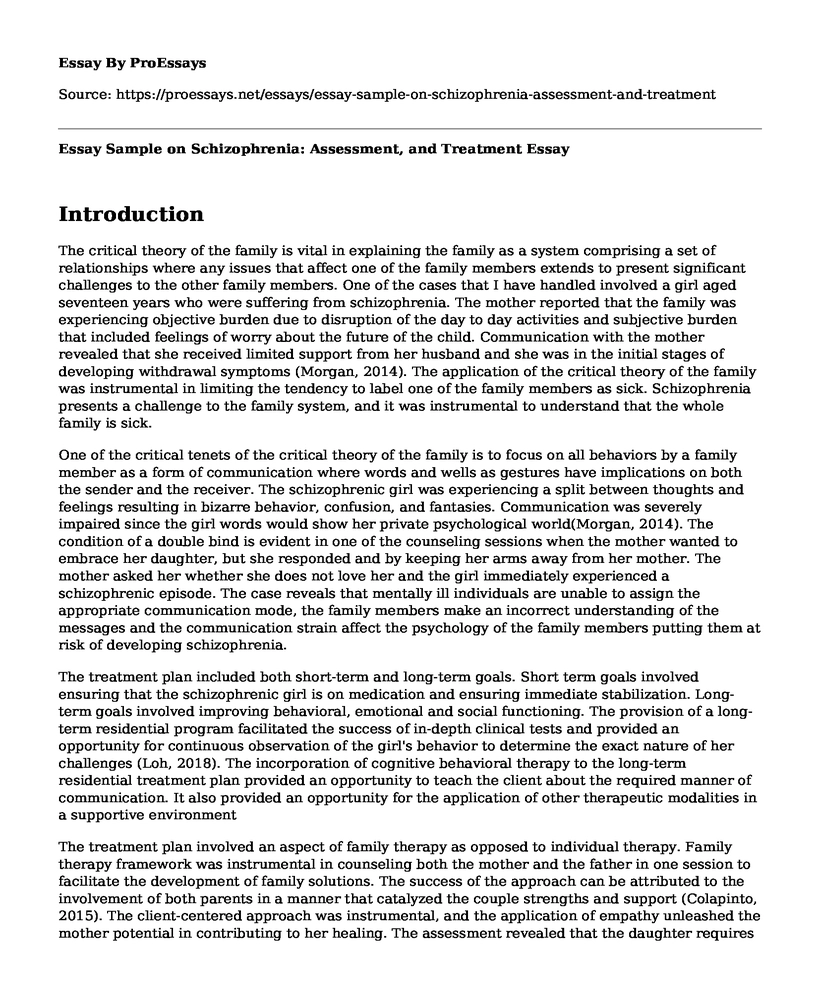Introduction
The critical theory of the family is vital in explaining the family as a system comprising a set of relationships where any issues that affect one of the family members extends to present significant challenges to the other family members. One of the cases that I have handled involved a girl aged seventeen years who were suffering from schizophrenia. The mother reported that the family was experiencing objective burden due to disruption of the day to day activities and subjective burden that included feelings of worry about the future of the child. Communication with the mother revealed that she received limited support from her husband and she was in the initial stages of developing withdrawal symptoms (Morgan, 2014). The application of the critical theory of the family was instrumental in limiting the tendency to label one of the family members as sick. Schizophrenia presents a challenge to the family system, and it was instrumental to understand that the whole family is sick.
One of the critical tenets of the critical theory of the family is to focus on all behaviors by a family member as a form of communication where words and wells as gestures have implications on both the sender and the receiver. The schizophrenic girl was experiencing a split between thoughts and feelings resulting in bizarre behavior, confusion, and fantasies. Communication was severely impaired since the girl words would show her private psychological world(Morgan, 2014). The condition of a double bind is evident in one of the counseling sessions when the mother wanted to embrace her daughter, but she responded and by keeping her arms away from her mother. The mother asked her whether she does not love her and the girl immediately experienced a schizophrenic episode. The case reveals that mentally ill individuals are unable to assign the appropriate communication mode, the family members make an incorrect understanding of the messages and the communication strain affect the psychology of the family members putting them at risk of developing schizophrenia.
The treatment plan included both short-term and long-term goals. Short term goals involved ensuring that the schizophrenic girl is on medication and ensuring immediate stabilization. Long-term goals involved improving behavioral, emotional and social functioning. The provision of a long-term residential program facilitated the success of in-depth clinical tests and provided an opportunity for continuous observation of the girl's behavior to determine the exact nature of her challenges (Loh, 2018). The incorporation of cognitive behavioral therapy to the long-term residential treatment plan provided an opportunity to teach the client about the required manner of communication. It also provided an opportunity for the application of other therapeutic modalities in a supportive environment
The treatment plan involved an aspect of family therapy as opposed to individual therapy. Family therapy framework was instrumental in counseling both the mother and the father in one session to facilitate the development of family solutions. The success of the approach can be attributed to the involvement of both parents in a manner that catalyzed the couple strengths and support (Colapinto, 2015). The client-centered approach was instrumental, and the application of empathy unleashed the mother potential in contributing to her healing. The assessment revealed that the daughter requires medical attention and the need to facilitate the mother understanding of her daughter mental situation to relieve any misunderstanding and worries. The mother narrated her experiences, and active listening was vital to assure her that I understood her feelings and concerns (Brooker & Latham, 2015). I recommended that she should identify her short-term wins, apply meditation and develop a behavior of mindfulness to avoid the stressful situation. I also identified that the family was in a financial crisis and I connected the mother with the social development officer for inclusion in the cash transfer program. The mother appreciated the comprehensive assistance that presented an understanding of her feelings, emotions and economic needs. The application of the person-centered approach was instrumental in producing positive changes before the next meeting.
References
Brooker, D., & Latham, I. (2015). Person-centered Dementia Care: Making Services Better with the VIPS Framework. Jessica Kingsley Publishers.
Colapinto, J. (2015). Structural family therapy. Handbook of Family Therapy (pp. 134-147). Routledge. NY: New York
Loh, S. Y. (2018). Interdisciplinary Rehabilitation to Facilitate Recovery of People Living with Long-Term Schizophrenia in Developing Countries.
Morgan, D. H. J. (2014). Social Theory and the Family (RLE Social Theory). Routledge. NY: New York.
Cite this page
Essay Sample on Schizophrenia: Assessment, and Treatment. (2022, Mar 26). Retrieved from https://proessays.net/essays/essay-sample-on-schizophrenia-assessment-and-treatment
If you are the original author of this essay and no longer wish to have it published on the ProEssays website, please click below to request its removal:
- Psychopathy
- Memory Research Paper Example
- Counseling Case Analysis: John Smith
- Research Paper on Media Influences on Aggression
- The Components of the Structure of Personality Essay
- Essay Sample on 'Beauty Standards': A Bane for Women's Mental and Physical Health
- Explaining Human Error Reasoning for Mental Health Treatment - Essay Sample







